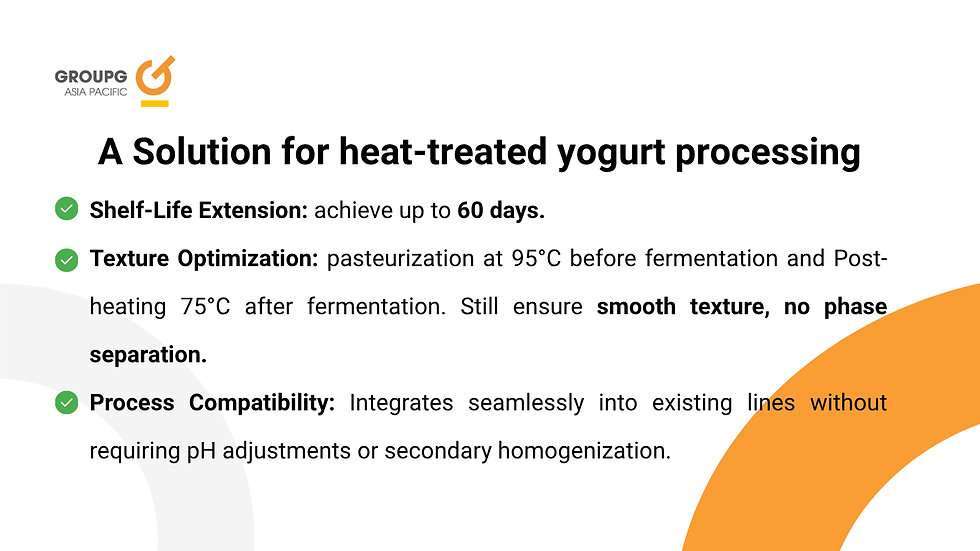Clean-Label Innovation in Extended Shelf-Life Pasteurized Stirred Yogurts
- internmarketing13
- Jun 10
- 3 min read
Updated: Jun 23
The global yogurt market with key segments including traditional stirred yogurt, drinkable yogurt, and post-fermentation heat-treated yogurt is experiencing strong growth, driven by rising consumer interest in health, convenient foods, and nutrition. According to a 2024 report by Statista, the global yogurt industry is expected to reach USD 194.99 billion in revenue in 2025, with a projected compound annual growth rate (CAGR) of 6.78% from 2025 to 2030. The Asia-Pacific region holds the largest market share at approximately 33%, led by China, which is the top-grossing country with an estimated revenue of USD 50 billion in 2025. While stirred yogurt with live cultures remains dominant in developed markets due to its digestive health benefits, heat-treated yogurts with extended shelf life are gaining traction in emerging markets thanks to their easier storage and distribution.

Key Benefits of Post-fermentation Heat-treated Stirred Yogurts
Post-fermentation heat-treated stirred yogurts offer distinct advantages that enhance product stability and streamline distribution across various markets, especially those in remote or less accessible regions. These benefits include:
Extended Shelf Life with a shelf life up to 60 days, significantly longer than the 21 to 35 days typical of conventional stirred yogurts. These products are better suited for long-distance transportation. This helps minimize spoilage and waste throughout the supply chain.
Reduced Sales Pressure in Distribution Channels: The extended shelf life eases inventory turnover requirements, allowing wholesalers and retailers more flexibility in managing stock. This results in lower pressure to sell quickly and reduces the risk of unsold expired goods.

Formulation Challenges in Post-fermentation Heat-treated Stirred Yogurts
While post-fermentation heat treatment extends shelf life, it may also introduce several technical challenges that affect product quality and marketability:
Increased Whey Separation:
The heat treatment process can disrupt the protein gel structure, leading to greater whey separation and a less desirable texture.
Flavor Alteration:
The typical mild sourness of yogurt may be reduced, and the product can develop a “cooked” or overly processed flavor, which may impact consumer acceptance.
Perceived Healthiness
Since the heat treatment inactivates live cultures, the yogurt may no longer be considered a probiotic or “live culture” product. Reintroducing beneficial bacteria post-treatment is necessary to maintain a health-focused positioning.
What’s the solution?
Discover the Clean-Label Stabilizer Designed for Heat-Treated Yogurt Processing
Scientific Foundation and Mechanism
This stabilizer leverages a synergistic blend of starch and gelatin to address texture and stability challenges in yogurts pasteurized at 75°C:
Starch: Modifies rheology by forming a heat-stable matrix that reduces syneresis, even in high-total solids formulations.
Gelatin: Enhances elasticity and smoothness through helical protein structures that withstand thermal denaturation.
This combination eliminates the need for E-number additives, aligning with clean-label trends.

Performance Advantages

Marketing Strategies for Dairy Manufacturers
Position this stabilizer as a solution for:
Clean-Label Formulation that Builds Consumer Trust
Cater to the growing demand for simple, recognizable ingredients. The stabilizer supports additive-free claims and helps you meet strict EU and APAC regulatory standards making it easier to label your product as “No Additives,” “No Preservatives”. FMCG Gurus’ research highlights that ‘clean label’ ranks among the top 10 food trends in Asia, and around 80% of consumers are attracted to the concept even though many aren’t fully clear on its meaning.
Smart Cost Efficiency Without Compromising Quality
Optimize your recipe by reducing dependency on costly dairy proteins like skim milk powder (SMP). The stabilizer balances starch and gelatin content to maintain texture and stability empowering brands to position their products as “High Quality, Lower Cost,” “Smartly Crafted,” or “Value Without Taste Sacrifice.”
Conclusion
The stabilizer represents a paradigm shift in stirred yogurt production, combining scientific rigor with market-driven innovation. By addressing texture defects and shelf-life constraints, this stabilizer empowers R&D teams to meet global demand for ambient yogurts without compromising on quality or label transparency. As the industry evolves toward convenience and sustainability, the solution stands as a critical enabler of next-generation dairy products.
👉 Ready to extend shelf life without compromising texture or label claims? Discover how GroupG can transform your stirred yogurt formulation.
Reference:

![[Event] Talkshow at Ho Chi Minh city University of Food Industry and G'Foundation Scholarship](https://static.wixstatic.com/media/35883f_da1a9f13267849239d9ce05ad476e9bb~mv2.jpeg/v1/fill/w_980,h_653,al_c,q_85,usm_0.66_1.00_0.01,enc_avif,quality_auto/35883f_da1a9f13267849239d9ce05ad476e9bb~mv2.jpeg)

Comments